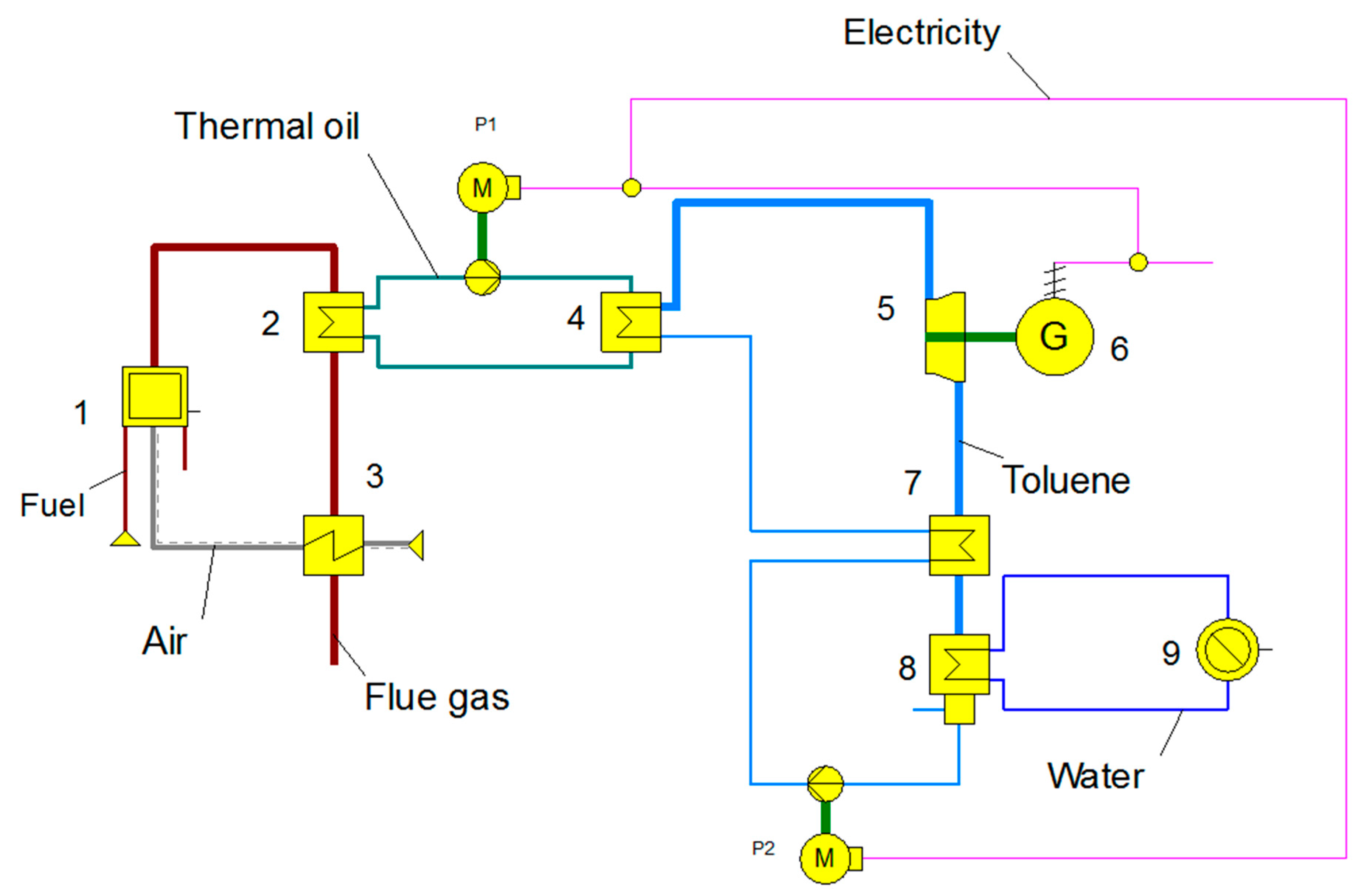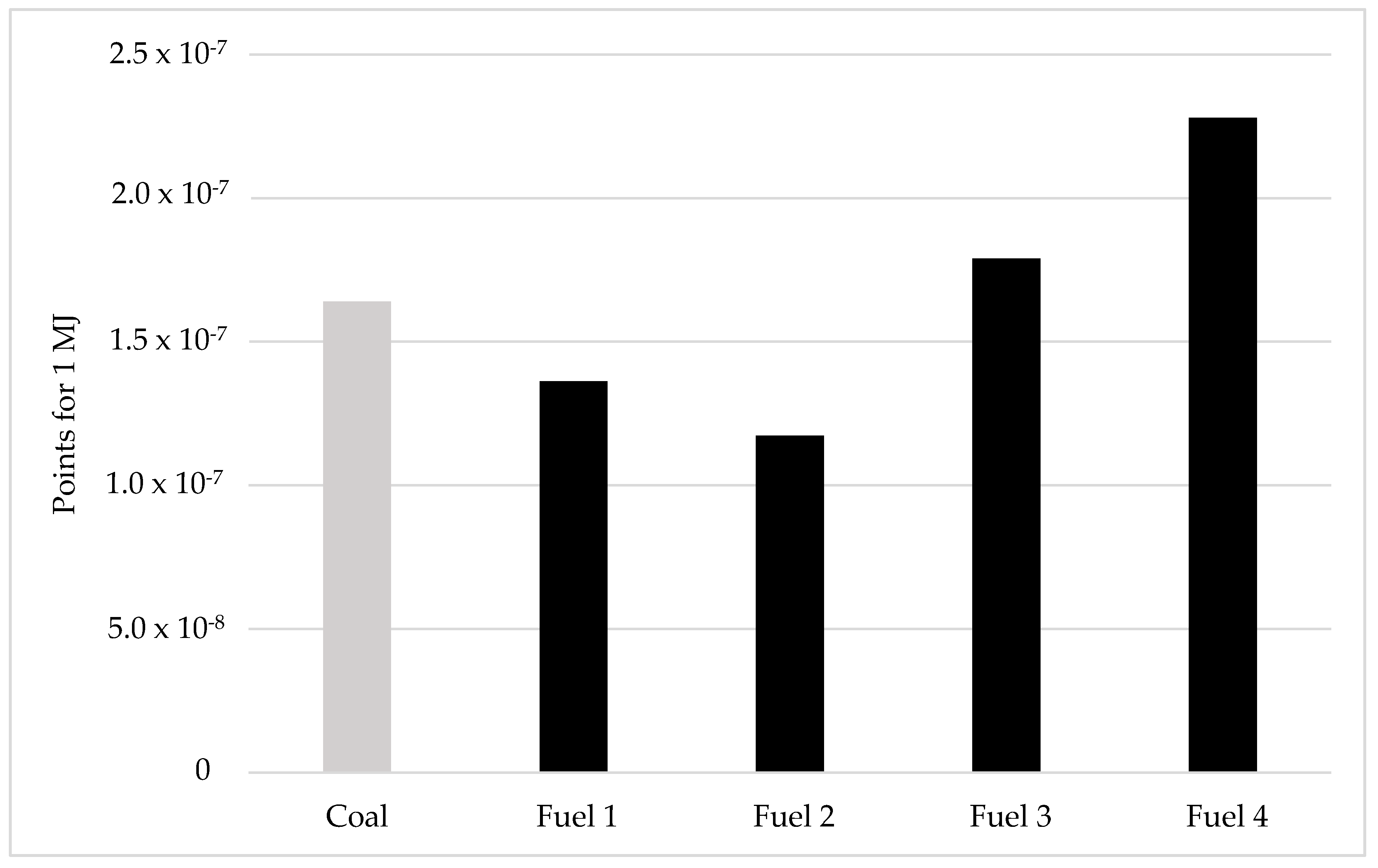Fuels from Waste as Renewable Energy in Distributed Generation on the Example of the ORC System
Abstract
:1. Introduction
2. Fuel from Waste
- (1)
- Refuse derived fuel (RDF)—selected combustible fraction of municipal waste, meeting defined energetic properties.
- (2)
- Solid recovered fuel (SRF)—selected combustible fraction of municipal waste with the admission of industrial waste presence, excluding dangerous waste, meeting defined energetic properties.
- (1)
- The first parameter is a factor describing economic potential of particular waste fuel, classified by its calorific value.
- (2)
- Parameter 2 is a factor describing a threat to technology due to the use of particular waste fuel, classified by the content of chlorine.
- (3)
- Parameter 3 is a factor describing safety for the environment during thermal treatment of particular fuel formed from waste, classified by the content of mercury.
3. Research Materials
- (1)
- Coal–hard coal which is extracted in ‘Sośnica’ coal mine, and used in the power industry.
- (2)
- Fuel 1–selected fraction of collected waste in Silesia (region of Poland), characterized by high calorific value. According to Table 1 (Quality requirements for particular classes of fuels formed from waste), it is class 21X (X lack of data).
- (3)
- Fuel 2–selected fraction of collected waste in Zagłebie Dąbrowskie (region of Poland), characterized by high calorific value. According to Table 1 (Quality requirements for particular classes of fuels formed from waste), it is class 321.
- (4)
- Fuel 3–Municipal polyolefins mixed with dried and granulated sludge. According to Table 1 (Quality requirements for particular classes of fuels formed from waste), it is class 411.
- (5)
- Fuel 4–Industrial waste. According to Table 1 (Quality requirements for particular classes of fuels formed from waste), the fuel was classified as 515.
4. Methods of Research
5. Model of Organic Rankine Cycle Dedicated for Fuel Form Waste
6. Results
7. Conclusions
Author Contributions
Funding
Conflicts of Interest
References
- The European Parliament and the Council of the European Union. Directive 2009/29/EC of the European Parliament and of the Council from 23 April 2009. Off. J. Eur. Union 2009, 30, 3–27. [Google Scholar]
- The European Parliament and the Council of the European Union. Directive 2009/406/EC of the European Parliament and of the Council from 23 April 2009. Off. J. Eur. Union 2009, 17, 126–138. [Google Scholar]
- The European Parliament and the Council of the European Union. Directive 2009/31/EC of the European Parliament and of the Council from 23 April 2009. Off. J. Eur. Union 2009, 26, 158–179. [Google Scholar]
- The European Parliament and the Council of the European Union. Directive 2009/28/EC of the European Parliament and of the Council from 23 April 2009. Off. J. Eur. Union 2009, 11, 39–85. [Google Scholar]
- Ministry of Energy. Polish Energy Policy until 2040; Ministry of Energy: Warsaw, Poland, 2018.
- 2020 Climate & Energy Package. Available online: https://ec.europa.eu/clima/policies/strategies/2020_en#tab-0-0 (accessed on 22 May 2019).
- EMEP/EEA Emission Inventory Guidebook (2013), Open Burning of Waste. Available online: https://www.eea.europa.eu/ds_resolveuid/UGS13MO6A5 (accessed on 7 May 2019).
- Uwarunkowania dla Wykorzystania Paliw z Odpadów w Energetyce i Ciepłownictwie. Available online: https://ekocykl.org/wp-content/uploads/2018/03/5_Ryszard_Wasielewski.pdf (accessed on 21 May 2019).
- Czop, M.; Poranek, N.; Czajkowski, A. Energetic usability and nuisance to the environment of selected fuels made of waste. Przemysł Chem. 2018, 97, 1460–1462. [Google Scholar]
- Energy Production & Changing Energy Sources. Available online: https://ourworldindata.org/energy-production-and-changing-energy-sources (accessed on 19 May 2018).
- Circular Economy. Available online: https://ec.europa.eu/growth/industry/sustainability/circular-economy_en (accessed on 20 May 2019).
- The European Parliament and the Council of the European Union. Directive 2018/850 of the European Parliament and of the Council 2018/850 from 30 May 2018. Off. J. Eur. Union 2018, L 150, 109–140. [Google Scholar]
- The European Parliament and the Council of the European Union. Directive 2012/22/EU of the European Parliament and of the Council from 25 August 2012. Off. J. Eur. Union 2012, L 227, 7–10. [Google Scholar]
- Polish Government. The act of 14 december 2012 on waste Poland. J. Laws 2018 2018, 2018, item 992. [Google Scholar]
- Internetowa Baza Danych o Odpadach, Rynek Paliw Alternatywnych 2016/2017. Available online: https://ibdo.pl/?page_id=771 (accessed on 31 April 2019).
- PN-EN 15359:2012. Fixed Secondary Fuel—Technical Requirements and Classes from 10.02.2012; Polish Committee for Standardization: Warszawa, Poland, 2012. [Google Scholar]
- Krajowy Ośrodek Bilansowania i Zarządzania Emisjami, Wskaźniki Emisji Zanieczyszczeń ze Spalania Paliw. Available online: https://krajowabaza.kobize.pl/docs/male_kotly.pdf (accessed on 3 May 2019).
- ReCiPe. Available online: https://www.rivm.nl/en/life-cycle-assessment-lca/recipe (accessed on 4 May 2019).
- Andreasen, J.G.; Kærn, M.R.; Haglind, F. Assessment of methods for performance comparison of pure and zeotropic working fluids for organic rankine cycle power systems. Energies 2019, 12, 1783. [Google Scholar] [CrossRef]
- Collings, P.; Mckeown, A.; Wang, E.; Yu, Z. Experimental investigation of a small-scale ORC power plant using a positive displacement expander with and without a regenerator. Energies 2019, 12, 1452. [Google Scholar] [CrossRef]
- Aracil, C.; Haro, P.; Fuentes-Cano, D.; Gómez-Barea, A. Implementation of waste-to-energy options in landfill-dominated countries: Economic evaluation and GHG impact. Waste Manag. 2018, 76, 443–456. [Google Scholar] [CrossRef] [PubMed]
- SedphoSate, S.; Chaiyat, N.; Gheewala, S.H.; Sampattagu, S. Conventional and exergetic life cycle assessment of organic rankine cycle implementation to municipal waste management: The case study of Mae Hong Son (Thailand). Int. J. Life Cycle Assess. 2017, 22, 1773–1784. [Google Scholar] [CrossRef]




| Classification Property | Statistical Value | Unit | Class | ||||
|---|---|---|---|---|---|---|---|
| 1 | 2 | 3 | 4 | 5 | |||
| Low calorific value (LCV) | Arithmetic average | MJ∙kg−1 | ≥25 | ≥20 | ≥15 | ≥10 | ≥3 |
| Chlorine content (Cl) | Arithmetic average | % | ≤0.2 | ≤0.6 | ≤1.0 | ≤1.5 | ≤3 |
| Mercury content (Hg) | Median | Mg∙MJ−1 | ≤0.02 | ≤0.03 | ≤0.06 | ≤0.08 | ≤0.16 |
| 80 percentile | Mg∙MJ−1 | ≤0.04 | ≤0.15 | ≤0.30 | ≤0.50 | ≤1.00 | |
| Parameter | Coal | Fuel 1 | Fuel 2 | Fuel 3 | Fuel 4 |
|---|---|---|---|---|---|
| Total moisture, % | 19.26 | 20.69 | 22.47 | 25.66 | 29.45 |
| Bulk density, kg∙m−3 | * | 37.10 | 27.50 | 298.00 | 300.00 |
| Combustible substances, % | 65.07 | 71.43 | 71.67 | 52.63 | 64.11 |
| Ash, % | 15.66 | 7.88 | 5.86 | 21.71 | 6.44 |
| Higher heating value, MJ∙kg−1 | 20.30 | 22.03 | 18.29 | 15.41 | 9.78 |
| Lower heating value, MJ∙kg−1 | 19.11 | 20.57 | 16.97 | 13.48 | 6.46 |
| Mercury (Hg), mg∙kg−1 | * | * | <0.4 | 0.27 | 1.85 |
| Mercury (Hg), mg∙MJ−1 | * | * | <0.024 | 0.02 | 0.29 |
| Parameter | Coal | Fuel 1 | Fuel 2 | Fuel 3 | Fuel 4 |
|---|---|---|---|---|---|
| Carbon (C), % | 52.10 | 50.32 | 34.63 | 40.32 | 25.77 |
| Hydrogen (H), % | 3.42 | 4.19 | 3.42 | 5.85 | 2.68 |
| Sulphur (S), % | 0.48 | 0.36 | 0.47 | 0.61 | 0.30 |
| Nitrogen (N), % | 1.23 | 0.46 | 0.88 | 3.76 | 1.61 |
| Chlorine (Cl), % | 0.13 | 0.08 | 0.41 | 0.11 | 0.11 |
| Oxygen (O) and other, % | 7.85 | 15.94 | 31.86 | 1.80 | 33.64 |
| Parameter | Coal | Fuel 1 | Fuel 2 | Fuel 3 | Fuel 4 |
|---|---|---|---|---|---|
| Electrical power, MWe | 1.08 | 1.10 | 1.07 | 1.03 | 0.83 |
| Thermal power, MWt | 3.31 | 3.35 | 3.27 | 3.15 | 2.54 |
| Total efficiency, % | 92.05 | 92.84 | 91.48 | 89.35 | 77.04 |
| Electrical efficiency, % | 22.72 | 22.92 | 22.58 | 22.06 | 19.02 |
| Thermal efficiency, % | 69.33 | 69.92 | 68.90 | 67.29 | 58.03 |
| Temperature of thermal oil, °C | 315/230 | 315/230 | 315/230 | 315/230 | 315/230 |
| Fuel flow, kg∙s−1 | 0.249 | 0.232 | 0.279 | 0.347 | 0.675 |
| Temperature of exhaust, °C | 108.27 | 102.74 | 101.67 | 102.33 | 110.84 |
| Parameter | Coal | Fuel 1 | Fuel 2 | Fuel 3 | Fuel 4 |
|---|---|---|---|---|---|
| (CO2), kg∙MJ−1 | 1.00 × 101 | 8.97 × 102 | 7.48 × 102 | 1.10 × 101 | 1.46 × 101 |
| (SO2), kg∙MJ−1 | 1.29 × 103 | 3.50 × 104 | 5.54 × 104 | 9.05 × 104 | 9.29 × 104 |
| (N2), kg∙MJ−1 | 4.13 × 101 | 3.65 × 101 | 2.57 × 101 | 5.64 × 101 | 4.37 × 101 |
| (O2), kg∙MJ−1 | 4.18 × 102 | 3.70 × 102 | 2.60 × 102 | 5.68 × 102 | 4.40 × 102 |
| (HCl), kg∙MJ−1 | 3.60 × 105 | 2.00 × 105 | 1.24 × 104 | 4.19 × 105 | 8.74 × 105 |
| (H2O), kg∙MJ−1 | 2.62 × 102 | 2.84 × 102 | 3.13 × 102 | 5.81 × 102 | 8.29 × 102 |
| (CO), kg∙MJ−1 | 2.62 × 104 | 1.99 × 106 | 2.42 × 106 | 1.15 × 103 | 6.35 × 106 |
| (NOx), kg∙MJ−1 | 1.96 × 105 | 1.30 × 105 | 1.58 × 105 | 4.64 × 105 | 4.14 × 105 |
| TSP, kg∙MJ−1 | 3.52 × 107 | 3.27 × 1010 | 3.94 × 1010 | 8.61 × 106 | 1.03 × 109 |
| (Hg), kg∙MJ−1 | 2.10 × 1010 | 1.37 × 1010 | 6.65 × 1017 | 6.91 × 1015 | 8.08 × 1016 |
© 2019 by the authors. Licensee MDPI, Basel, Switzerland. This article is an open access article distributed under the terms and conditions of the Creative Commons Attribution (CC BY) license (http://creativecommons.org/licenses/by/4.0/).
Share and Cite
Czop, M.; Poranek, N.; Czajkowski, A.; Wagstyl, Ł. Fuels from Waste as Renewable Energy in Distributed Generation on the Example of the ORC System. Recycling 2019, 4, 26. https://doi.org/10.3390/recycling4030026
Czop M, Poranek N, Czajkowski A, Wagstyl Ł. Fuels from Waste as Renewable Energy in Distributed Generation on the Example of the ORC System. Recycling. 2019; 4(3):26. https://doi.org/10.3390/recycling4030026
Chicago/Turabian StyleCzop, Monika, Nikolina Poranek, Adrian Czajkowski, and Łukasz Wagstyl. 2019. "Fuels from Waste as Renewable Energy in Distributed Generation on the Example of the ORC System" Recycling 4, no. 3: 26. https://doi.org/10.3390/recycling4030026
APA StyleCzop, M., Poranek, N., Czajkowski, A., & Wagstyl, Ł. (2019). Fuels from Waste as Renewable Energy in Distributed Generation on the Example of the ORC System. Recycling, 4(3), 26. https://doi.org/10.3390/recycling4030026






